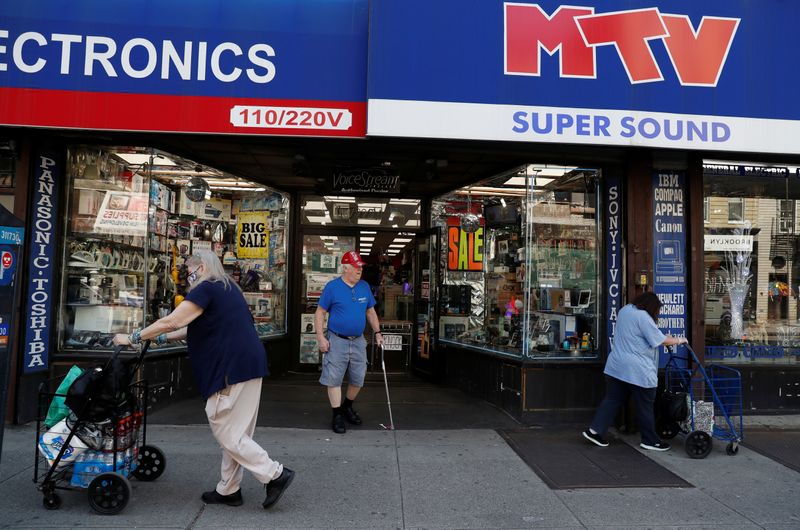By Lucia Mutikani
WASHINGTON (Reuters) - U.S. consumer spending increased for a second straight month in June, setting up consumption for a rebound in the third quarter, though the recovery could be limited by a resurgence in COVID-19 cases and the end of expanded unemployment benefits.
Concerns about sky-rocketing coronavirus infections and the expiring jobless benefits hurt consumer sentiment in July, other data showed on Friday. Robust consumer spending is critical to reviving the economy after it suffered its biggest blow since the Great Depression in the second quarter.
"The June data confirm the strong initial phase of the recovery, but we caution that rear-view mirror economics could drive us off a cliff," said Gregory Daco, chief U.S. economist at Oxford Economics in New York. "Low-income families have nearly regained pre-COVID spending levels supported by strong fiscal aid, but with numerous assistance programs expiring, and a mismanaged health crisis constraining spending on services, the second phase of the recovery will likely be much slower."
Consumer spending, which accounts for more than two-thirds of U.S. economic activity, rose 5.6% last month after a record 8.5% jump in May as more businesses reopened, the Commerce Department said.
Consumers boosted purchases of clothing and footwear. They also spent more on healthcare, dining out and on hotel and motel accommodation, though outlays on services remained lackluster because of caution sparked by the virus.
Economists polled by Reuters had forecast consumer spending would advance 5.5% in June. When adjusted for inflation, consumer spending rose 5.2% after surging 8.4% in May.
The data was included in Thursday's advance gross domestic product report for the second quarter, which showed the economy shrinking at a record 32.9% annualized rate, the steepest decline since the government started keeping records in 1947. Consumer spending tanked at a historic 34.6%.
With June's increase, consumer spending has pulled out of April's deep hole, but remains 6.9% below its pre-pandemic level. This puts spending on a higher growth trajectory heading into the July-September quarter.
But the explosion of COVID-19 infections, especially in the densely populated South and West regions where authorities in hard-hit areas are closing businesses again and pausing reopenings, is casting doubt on the magnitude of the expected surge in third-quarter consumer spending.
In addition, tens of millions of unemployed Americans will at midnight on Friday lose $600 (456.7 pounds) in additional weekly jobless benefits after the White House and Congress failed to reach an agreement to extend the supplement, which has allowed them to pay rent and buy food among other expenses.
A separate report from the University of Michigan on Friday showed its consumer sentiment index dropped to a reading of 72.5 this month from 78.1 in June.
Stocks on Wall Street were mixed. The dollar (DXY) was steady against a basket of currencies. Prices of shorter-dated U.S. Treasuries were slightly higher. Graphic: Unemployment benefits and total personal income - https://fingfx.thomsonreuters.com/gfx/mkt/jznvnkjoqpl/Pasted%20image%201596205723376.png
ALL EYES ON CONGRESS
The extra unemployment checks are worth about $75 billion per month and accounted for nearly 5% of personal income in June. A staggering 30.2 million Americans were receiving unemployment checks in the week ending July 11. Though government welfare payments have been declining after jumping 110% in April, unemployment benefits increased 8.5% in June.
"If Congress does not quickly extend these programs, and in light of the recent loss of momentum in the economy, the impact on household wellbeing and economic activity may be severe," said Steven Friedman, senior macroeconomist at MacKay Shields in New York. "Strong federal support for households will likely be necessary until the virus is contained."
Government transfer payments decreased 8.9% last month, leading to a 1.1% fall in income, on top of May's 4.4% drop. Wages increased 2.2% after rebounding 2.6% in May. With the unemployment rate at 11.1% and COVID-19 slowing the labor market recovery, wage growth could slow further.
A third report on Friday from the Labor Department showed the smallest wage increase in five years in the second quarter.
Historically high savings could keep consumer spending supported while lawmakers and the Trump administration seek a deal on extending the enhanced jobless benefits.
Consumers socked away $1.3 trillion over the last three months. Savings funded spending last month, pulling the saving rate down to a still-high 19% from 24.2% in May.
While higher food and energy goods and services prices lifted monthly inflation last month, the trend was muted.
The personal consumption expenditures (PCE) price index excluding the volatile food and energy components rose 0.2%, matching May's gain. In the 12 months through June, the so-called core PCE price index rose 0.9% after increasing 1.0% in May. The core PCE index is the preferred inflation measure for the Federal Reserve's 2% target.
"This should allow the Fed to be as expansionary as it wants without inflationary consequences," said David Berson, chief economist at Nationwide in Columbus, Ohio.

The U.S. central bank on Wednesday kept interest rates near zero and pledged to continue pumping money into the economy.